Related Research Articles

The Federal Emergency Management Agency (FEMA) is an agency of the United States Department of Homeland Security (DHS), initially created under President Jimmy Carter by Presidential Reorganization Plan No. 3 of 1978 and implemented by two Executive Orders on April 1, 1979. The agency's primary purpose is to coordinate the response to a disaster that has occurred in the United States and that overwhelms the resources of local and state authorities. The governor of the state in which the disaster occurs must declare a state of emergency and formally request from the President that FEMA and the federal government respond to the disaster. The only exception to the state's gubernatorial declaration requirement occurs when an emergency or disaster takes place on federal property or to a federal asset—for example, the 1995 bombing of the Alfred P. Murrah Federal Building in Oklahoma City, Oklahoma, or the Space Shuttle Columbia in the 2003 return-flight disaster.

Kathleen Babineaux Blanco was an American politician who served as the 54th Governor of Louisiana from January 2004 to January 2008. A member of the Democratic Party, she was the first and, to date, only woman elected as the state's governor.

Charles Joseph Melançon is an American politician and the former secretary of the Louisiana Department of Wildlife and Fisheries.

National Civilian Community Corps (NCCC), or AmeriCorps NCCC is an AmeriCorps program that engages 18- to 24-year-olds in team-based national and community service in the United States. Under the CARES act, however, the maximum age of entry is 26. National Civilian Community Corps teams complete about four different six- to eight-week-long projects during their 10-month term of service. Each team is made up of eight to twelve Corps Members and one Team Leader. Corps Members and Team Leaders are representative of all colors, creeds, states, and economic status. Approximately 1,200 Corps Members and Team Leaders are chosen annually to serve at one of four regional campuses, located in Sacramento, California; Denver, Colorado; Vinton, Iowa; and Vicksburg, Mississippi. Each campus serves as a training center and hub for a multi-state region. Members are required to complete a minimum of 1,700 hours of service, including 80 independent service hours, though members complete an average of 1,850 service hours per term.
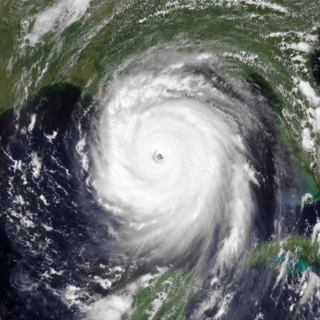
Hurricane Katrina was a large and destructive Category 5 Atlantic hurricane that caused over 1,800 fatalities and $125 billion in damage in late August 2005, especially in the city of New Orleans and the surrounding areas. It was at the time the costliest tropical cyclone on record and is now tied with 2017's Hurricane Harvey. The storm was the twelfth tropical cyclone, the fifth hurricane, and the third major hurricane of the 2005 Atlantic hurricane season, as well as the fourth-most intense Atlantic hurricane on record to make landfall in the contiguous United States.

Criticism of the government response to Hurricane Katrina consisted primarily of condemnations of mismanagement and lack of preparation in the relief effort in response to Hurricane Katrina and its aftermath. Specifically, there was a delayed response to the flooding of New Orleans, Louisiana.

The disaster recovery response to Hurricane Katrina included federal government agencies such as the Federal Emergency Management Agency (FEMA), the United States Coast Guard (USCG), state and local-level agencies, federal and National Guard soldiers, non-governmental organizations, charities, and private individuals. Tens of thousands of volunteers and troops responded or were deployed to the disaster; most in the affected area but also throughout the U.S. at shelters set up in at least 19 states.

Hurricane Katrina's winds and storm surge reached the Mississippi coastline on the morning of August 29, 2005. beginning a two-day path of destruction through central Mississippi; by 10 a.m. CDT on August 29, 2005, the eye of Katrina began traveling up the entire state, only slowing from hurricane-force winds at Meridian near 7 p.m. and entering Tennessee as a tropical storm. Many coastal towns of Mississippi had already been obliterated, in a single night. Hurricane-force winds reached coastal Mississippi by 2 a.m. and lasted over 17 hours, spawning 11 tornadoes and a 28-foot storm surge flooding 6–12 miles (10–19 km) inland. Many, unable to evacuate, survived by climbing to attics or rooftops, or swimming to higher buildings and trees. The worst property damage from Katrina occurred in coastal Mississippi, where all towns flooded over 90% in hours, and waves destroyed many historic buildings, with others gutted to the 3rd story. Afterward, 238 people died in Mississippi, and all counties in Mississippi were declared disaster areas, 49 for full federal assistance. Regulations were changed later for emergency centers and casinos. The emergency command centers were moved higher because all 3 coastal centers flooded at 30 ft (9 m) above sea level. Casinos were allowed on land rather than limited to floating casino barges as in 2005.
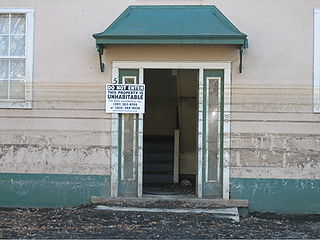
The reconstruction of New Orleans refers to the rebuilding process endured by the city of New Orleans after Hurricane Katrina destroyed much of the city on August 29, 2005. The storm caused levees to fail, releasing tens of billions of gallons of water. The levee failure contributed to extensive flooding in the New Orleans area and surrounding parishes. About 80% of all structures in Orleans Parish sustained water damage. Over 204,000 homes were damaged or destroyed, and more than 800,000 citizens displaced—the greatest displacement in the United States since the Dust Bowl of the 1930s. Wind damage was less severe than predicted. The damage that took place that needed to be repaired cost about $125 billion.

This article contains a historical timeline of the events of Hurricane Katrina on August 23–30, 2005 and its aftermath.
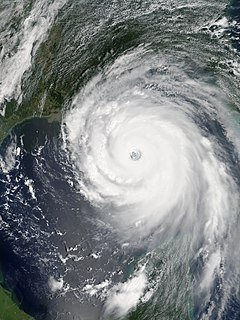
Hurricane Katrina struck the United States on August 29, 2005, causing over a thousand deaths and extreme property damage, particularly in New Orleans. The incident affected numerous areas of governance, including disaster preparedness and environmental policy.
Louisiana Speaks was a regional plan, published in May 2007, and planning organization for southern Louisiana created in the wake of the destruction caused by Hurricanes Katrina and Rita.
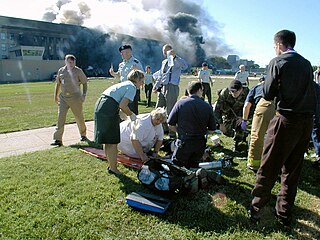
Disaster medicine is the area of medical specialization serving the dual areas of providing health care to disaster survivors and providing medically related disaster preparation, disaster planning, disaster response and disaster recovery leadership throughout the disaster life cycle. Disaster medicine specialists provide insight, guidance and expertise on the principles and practice of medicine both in the disaster impact area and healthcare evacuation receiving facilities to emergency management professionals, hospitals, healthcare facilities, communities and governments. The disaster medicine specialist is the liaison between and partner to the medical contingency planner, the emergency management professional, the incident command system, government and policy makers.
The Gulf Coast Civic Works Bill was a bill introduced in the US Congress in 2007 as H.R. 4048, intended to establish a regional authority to fund resident-led recovery projects. It died in committee and was reintroduced in edited form in 2009, again dying in committee.
Camp Restore is a Christian organization that operates a shelter for up to 240 people at the Prince of Peace Lutheran church in New Orleans East. First opened on September 10, 2006, these accommodations are used to house volunteers from across the United States as they help rebuild homes and buildings in the surrounding communities that had been destroyed by Hurricane Katrina. It also has locations in Baton Rouge and Detroit.
Aid Still Required (ASR) is a not for profit 501(c)(3) organization committed to bringing attention and humanitarian aid to areas suffering from natural disasters or human crises. Incorporated in Santa Monica, California, US, in 2008 as a result of founders Hunter and Andrea Herz Payne's three-year journey following the December 2004 Southeast Asian tsunami. The name, "Aid Still Required" and the mission were born out of the need to bring these issues back into the spotlight after they have left the news headlines and public awareness. Aid Still Required indicates its commitment to finding innovative ways to build back these regions through environmentally sustainable means. Future project locations are Thailand, Appalachia, NYC First Responders, Haiti, and the Gulf Oil.

Jodey Cook Arrington is an American politician serving as the U.S. representative for Texas's 19th congressional district. The district includes a large slice of West Texas, centered around Lubbock and Abilene. He is a member of the Republican Party.
The National Disaster Recovery Framework (NDRF) is a guide published by the US Government to promote effective disaster recovery in the United States, particularly for those incidents that are large-scale or catastrophic. The NDRF was released in September 2011 by the Federal Emergency Management Agency (FEMA).

Public Law 113-2, containing Division A: Disaster Relief Appropriations Act, 2013 and Division B: Sandy Recovery Improvement Act of 2013 is a U.S. appropriations bill authorizing $60 billion for disaster relief agencies. The Budget Control Act of 2011 (BCA), had authorized only disaster spending and emergency spending to exceed established spending caps. While emergency spending is not subject to the caps in the BCA, spending for disaster relief is calculated by taking the average of the previous ten years disaster relief spending, excluding the highest and lowest spending years.
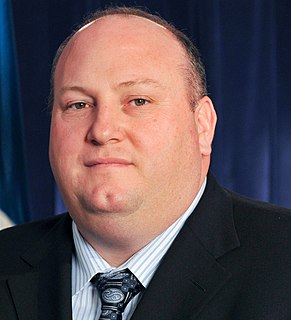
Robert J. Fenton Jr is an American governmental official who worked for the Federal Emergency Management Agency (FEMA) in 1996 and was appointed Regional Administrator for FEMA Region IX: Arizona, California, Hawaii, Nevada, and the Pacific Islands in July 2015. He had a leadership role in the development of the National Incident Management System and the National Response Framework.
References
- ↑ Office of the Press Secretary (November 1, 2005). "Executive Order Establishment of a Coordinator of Federal Support for the Recovery and Rebuilding of the Gulf Coast Region". whitehouse.gov . Washington, D.C.: White House . Retrieved April 11, 2017.
- ↑ Office of the Press Secretary (November 4, 2005). "Establishment of a Coordinator of Federal Support for the Recovery and Rebuilding of the Gulf Coast Region". Federal Register . Washington, D.C.: Federal Government of the United States. Archived from the original on September 12, 2016. Retrieved April 11, 2017. Alt URL
- ↑ Donald Powell's testimony before Senate Subcommittee on Disaster Recovery Archived from the original 2012-04-04.